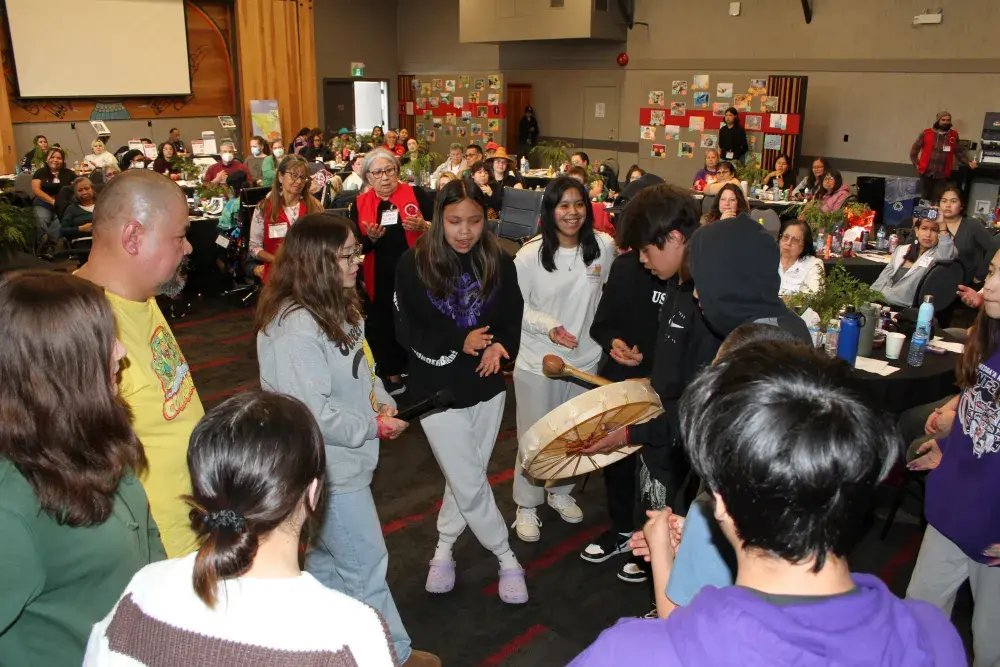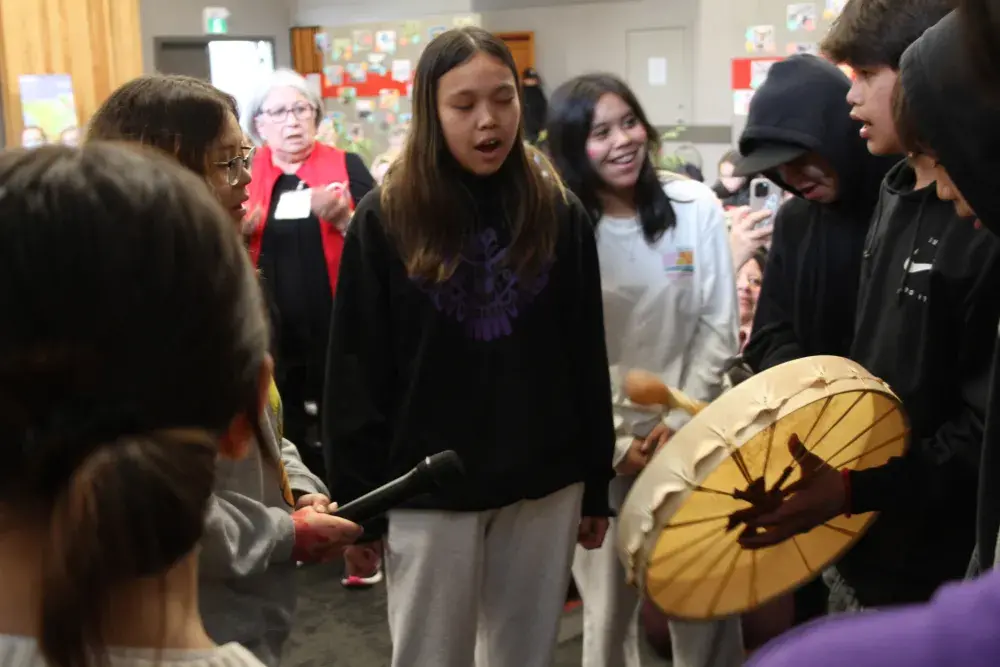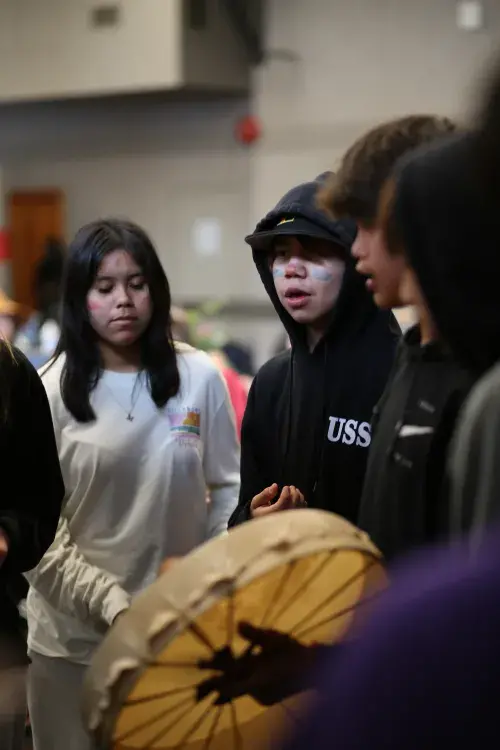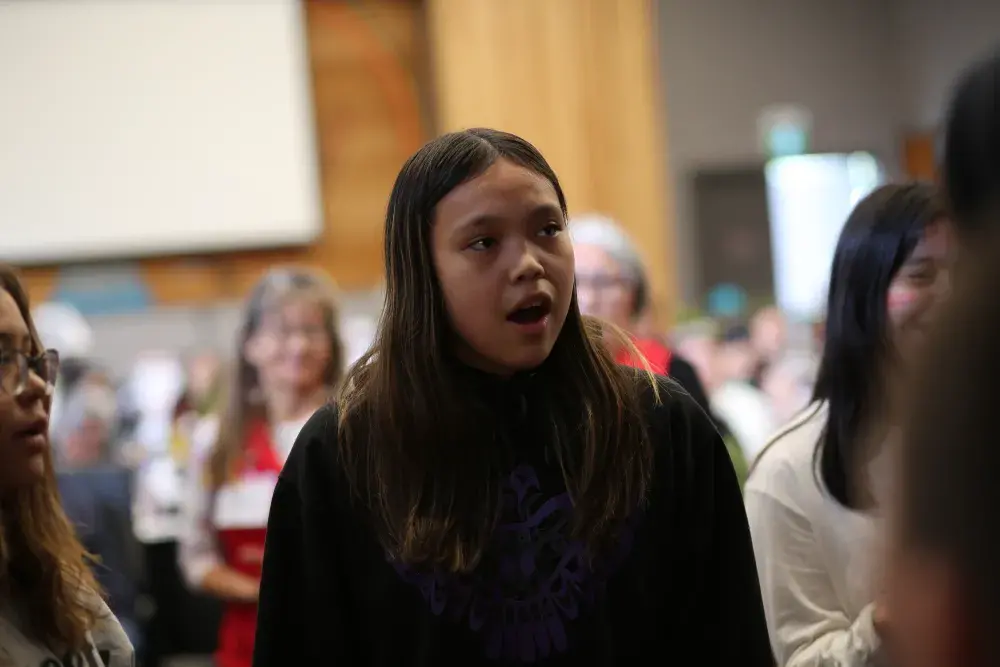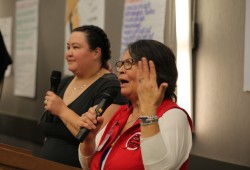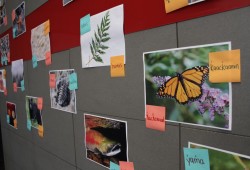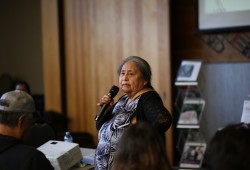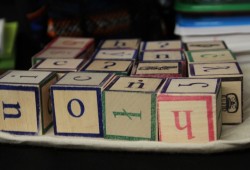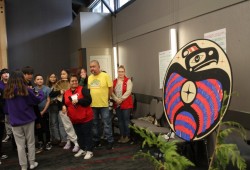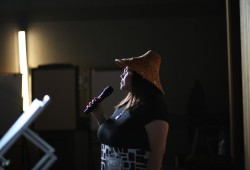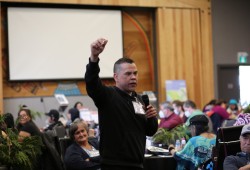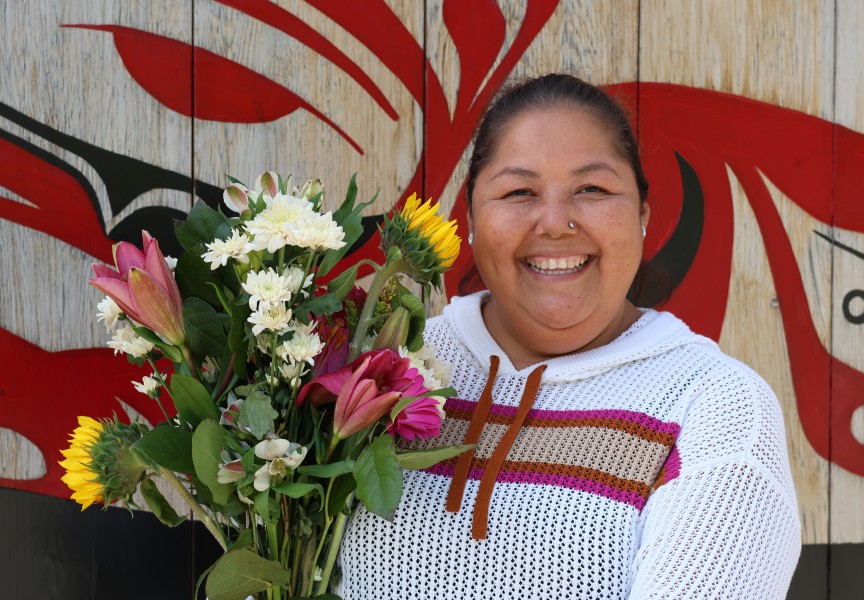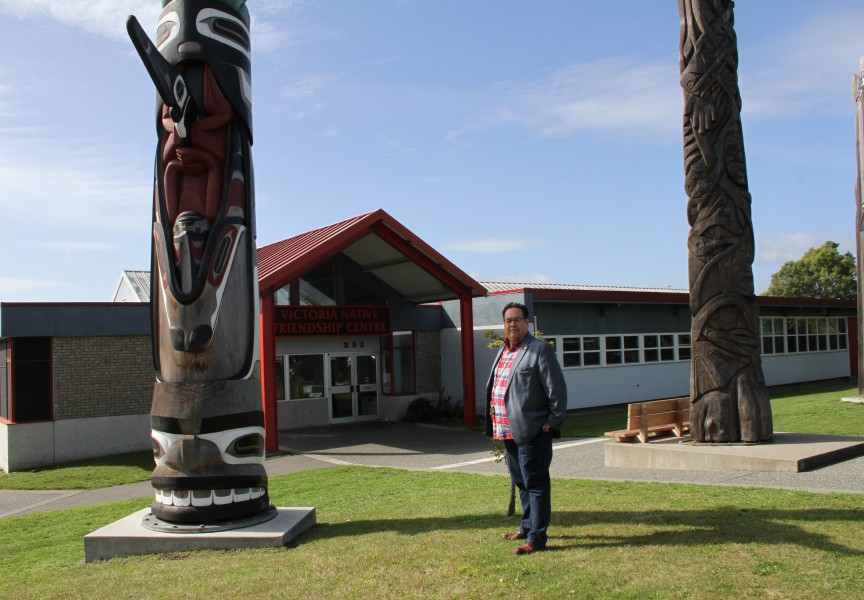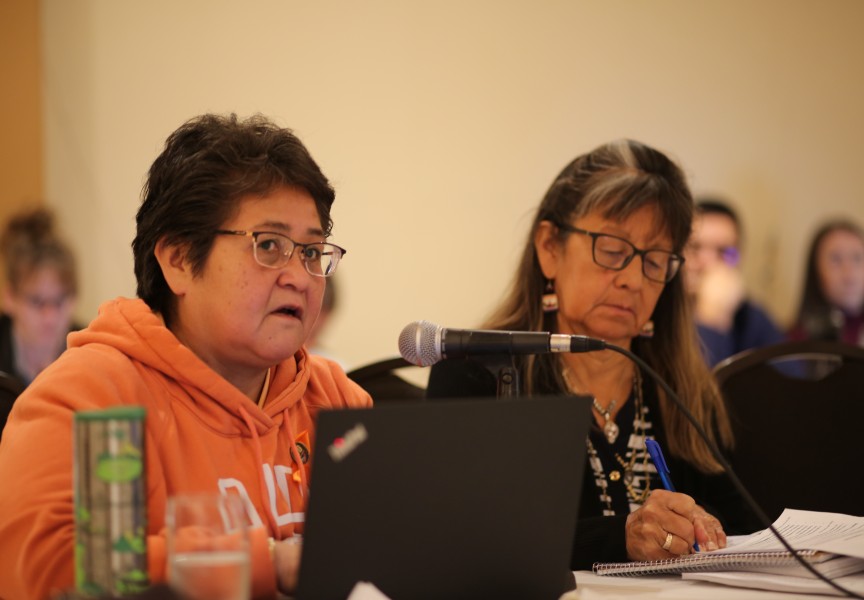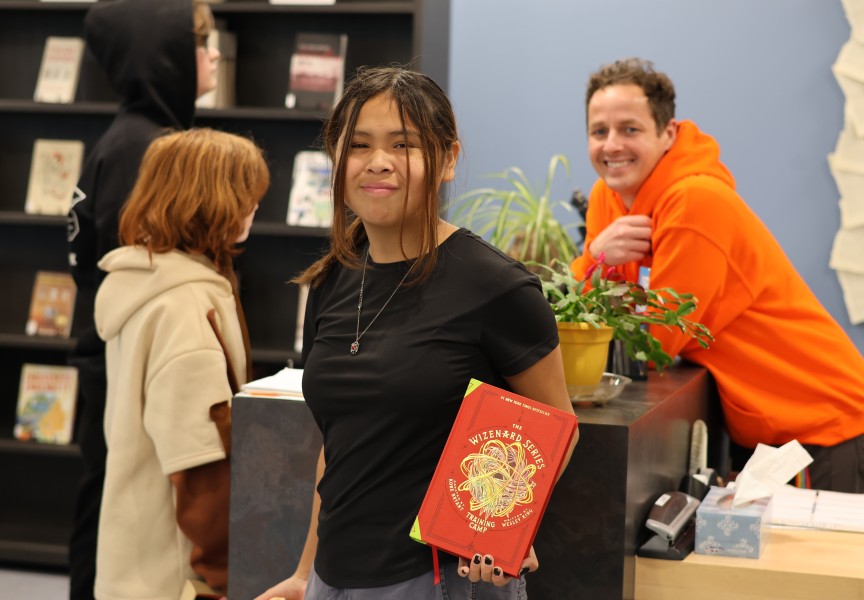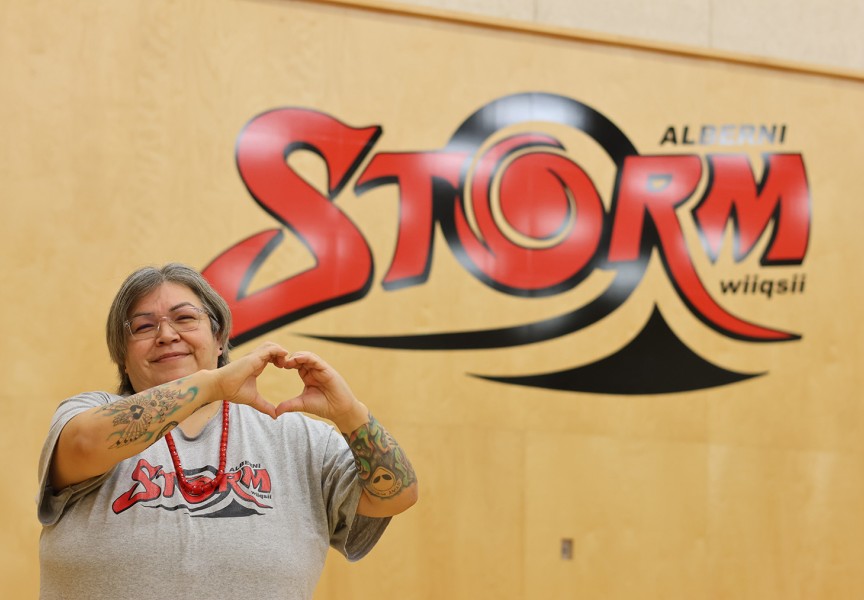Sisters čiisma and Tuu paat have spoken their Indigenous dialects - without interruption - for every day of their long lives. For elders aged 76 and 81 respectively, this would have been normal 150 years ago. But as Nuu-chah-nulth-aht head deeper into the 21st century, and all of the assimilation that comes with being part of what is now Canada, the presence of speakers fluent in their Ahousaht dialect is becoming an increasingly critical resource with each passing year.
It's April 26, and čiisma and Tuu paat, whose English names are Patti Frank and Julia Lucas, are surrounded by over a 100 people at the Best Western Tin Wis hotel’s conference room in Tofino. This is day two of a three-day language gathering hosted by the Tla-o-qui-aht First Nation, drawing participants from across western Vancouver Island, from Ditidaht territory in the south to Kyuquot on the northwest.
All are gathered to explore the revitalization of the ancestral Nuu-chah-nulth language. Possibly more than any other issue these days, it’s a concern that unites the tribes of Vancouver Island’s west coast. The gathering follows the declaration of a state of emergency for the loss of language and culture that was passed at the Nuu-chah-nulth Tribal Council’s Annual General Meeting on Nov. 30.
c̕iiʔiłumqa, Anna Masso, Tla-o-qui-aht’s language coordinator, supports the state of emergency declaration, but believes it came several years too late.
“We need to move faster in language learning as we are losing our resources, our elders, our fluent speakers,” says Masso. “They’re getting harder and harder to find. Very few, especially the ones that can write.”
The trend in concerning, and has been for many years. Back in 2010 the First Peoples Cultural Council classified Nuu-chah-nulth as “nearly extinct” in a report on the state of Indigenous languages in British Columbia. That report assessed B.C.’s 32 Indigenous languages, encompassing 59 dialects, to determine that just 5.1 per cent of the province’s Aboriginal people were fluent in their native language. Nuu-chah-nulth fell well below this mark with less than two per cent of the population at the time, with a 115 fluent speakers and another 12 in the Ditidaht dialect.
“We need to have a revolution,” said former NTC president Wickaninnish, Cliff Atleo, after the report was released.
More than a decade later, the number of fluent Nuu-chah-nulth speakers has continued to dwindle. The cultural council’s last report in 2022 listed 73 fluent Nuu-chah-nulth speakers, with another five speaking Ditidaht.
“In Tla-o-qui-aht we have one that can read and write, and we have maybe a handful, a half dozen or so,” says Masso, counting the fluent elders in her First Nation. “In our Tla-o-qui-aht language class we have three elders that we rely on. Whereas, five, 10 years back we could have a whole classroom.”
Masso looks to two tables in the Tin Wis conference room where čiisma and Tuu paat sit with a handful of other elders who are fluent in their ancestral dialects.
“They need to understand these two very small tables here is all we have to draw from to save our language,” she remarks. “Those two small tables there are all we have left.”
The need for immersion
čiisma lives in Port Alberni now, across the water and far inland from her homeland of Ahousaht. These days, most of her day-to-day dealings are in English, and she admits that normally her thoughts are as well. But there are times at night when she dreams in the Ahousaht dialect that surrounded her during childhood.
“It’s more meaningful when we speak our language,” says čiisma.
She explains that if offering condolences after someone has lost a loved one, she would say ʔaʔaaʔał ḥ suwa (pronounced awe awe alth suu wah).
“I’m saying, my heart is slashed, bleeding with pain,” explains čiisma.
čiisma and Tuu paat grew up with their siblings in 21-person household in the Ahousaht village of Maaqtusiis. There were three families, an older couple and her sister-in-law’s father living in the large quarters. It was a time when she recalls never being alone, surrounded by Nuu-chah-nulth language and stories.
čiisma remembers the elder Robert Joseph, who lived in the house with the families and couple.
“He would always be telling us stories, smoking away,” she remembers. “He was a storyteller, himwitsa. He would gather us around at night and we’d all listen to stories.”
čiisma and Tuu paat didn’t learn English until they attended the Ahousaht Day School at the age of 6. Unlike some others from her generation who were sent to residential school, čiisma’s ancestral dialect still surrounded her at home, but at the day school it was strictly English.
“The only word I knew in English was ‘Yes’,” she says of when she started day school. “We’d get in trouble if we spoke our language. We’d get quiet, didn’t want to get into trouble. You watched what others did.”
čiisma went through Grade1 without learning English, but her thirst for knowledge eventually changed this.
“I started pushing myself to learn. I learned how to read and I loved that,” says čiisma, who soon read anything she could get her hands on as a youngster. “I went to Grade 8, but I educated myself. I read the whole encyclopedia set, just to learn.”
Two generations later, the opposite is often the case, as English is the common language in Nuu-chah-nulth communities. For the last 13 years Daisy Hanson has been teaching the Ka:'yu:'k't'h'/Che:k'tles7et'h' dialect at the Kyuquot Elementary Secondary School, where Nuu-chah-nulth is integrated into everyday communication beyond the regular language classes. Hanson believes that expanding this to an immersion program would help to further language revitalization, something that could be possible in the future as the Ka:'yu:'k't'h'/Che:k'tles7et'h' First Nations have hopes of eventually running the school.
“It stops at school. Once they get out that door the language stops,” says Hanson. “If we could keep this consistency everywhere, consistency is the key. Immersion and consistency.”
She finds that the younger grades are particularly effective in picking up the Ka:'yu:'k't'h'/Che:k'tles7et'h' dialect.
“They’re like magic little sponges, they pick up the sounds really easily,” says Hanson. “The teaching is going from me to the students to the parents, which is a good thing.”
Language is culture
Hanna Frank is a very busy teenager. The Tla-o-qui-aht member is a Grade11 student at Shawnigan Lake, a private boarding school in southeastern Vancouver Island. It’s a life far removed from home, except for the three-hour online sessions she participates in to learn Nuu-chah-nulth each week. Although she’s the only one in the school taking these classes, her peers are supportive, often bringing her dinner as Frank participates in the three evening sessions per week.
“It’s a lot of work to stay focused,” she admits, noting that the sessions usually entail working for one to two hours with a fluent speaker, followed by exercises in conversation. “We’ll ask, ‘How are you?’ and stuff like that.”
Frank has been learning Nuu-chah-nulth since she was a younger child, an endeavor that carries a deep meaning to her.
“My late dad, Bruce Frank, he wanted me to know language is a part of who we are and is a part of our identity,” she reflects, recalling when her parents tested her on their chiefs’ names. “It gets tough being away from culture, so on my phone I have a lot of recordings of songs. I listen to that when I go to bed. Now that I’m doing that there’s one song that I’ve memorized, and that makes me very happy.”
Frank’s goal is to become fluent, although she doesn’t expect to reach this until she’s in her 50s or 60s.
“It’s important to me because I want the language to stay alive. I’m seeing it right now with other nations where we’re losing the language,” she says. “That’s my biggest fear. My goal is to become fluent, or to know a lot of language. My other goal is to make sure the other people my age, my generation, are taking it seriously.”
There are young people taking it seriously, including five who graduated last summer with Bachelor of Education degrees in Indigenous language, with a specialization in Nuu-chah-nulth, through the University of Victoria. Four of these graduates are currently teaching in their communities.
ḥakaƛ, Chrissie John of Ehattesaht, was one of these grads who spoke at the recent language gathering.
“The most language I learned in that program was with elders, because our elders are the professors,” explains John. “We can’t turn to books, we can’t turn to old articles – although there are some with our language and culture – but we can’t become fluent that way.”
John integrates Nuu-chah-nulth language into the day-to-day upbringing of her two young children, who are aged three and one and a half. During her presentation at Tin Wis she used the words of Tuu paat, one of her teachers.
“She said ‘Language and culture are interdependent’,” recalls John. “If you’re doing something cultural it has language in it, always. If you’re learning language, you also have to learn culture.”
An ‘essential step to reconciliation’
This year efforts to revitalize Indigenous languages face increased difficulty with a drop in federal funding. Support for Aboriginal language programs in B.C. comes from the First Peoples Cultural Council, which lost 58 per cent of its government funding with Ottawa’s 2024 budget.
This returns the current stream of federal funding to 2019 levels, explains the cultural council’s CEO Tracey Herbert.
“So many First Nations have used the funding to develop long-term plans for revitalizing their languages,” she says. “Now those plans are being interrupted by this lack of commitment.”
Courtenay-Alberni MP Gord Johns recently brought up the issue in the House of Commons.
“Preserving and revitalizing Indigenous languages is an essential step to reconciliation,” said Johns in the House on April 9. “Will this government remember its most important relationship with First Nations and act with urgency to ensure sustained and long-term funding to language programs in British Columbia?”
In her response Minster of Indigenous Services Patty Hajdu acknowledged the need for Indigenous language programs, but avoided specifically addressing the shortfall in British Columbia, home to 60 per cent of Canada’s languages.
“In my own riding Matawa Tribal Council provides First Nations language training and support for First Nations communities all through northern Ontario supported by this federal government,” responded Hajdu. “I’m very proud of the work they’re doing, and we will continue to work on this preservation with First Nations across the country.”
An uphill climb
The First Peoples Cultural Council defines a fluent speaker as someone who can converse and understand a language without the use of English. Although this number continues to decline, there are some encouraging indications that could prevent the extinction of Nuu-chah-nulth and other Indigenous languages in B.C. Across the province, the number of language learners increased by 22 per cent from 2018 to 2022.
“We’re creating more opportunities to use the language in multiple domains - in the home, in the community, at school,” says Herbert, pointing to a program in central Canada that has moved learners closer to fluency. “It’s really those immersion-style programs, both here in B.C. and there’s a really successful one in the Mohawk territory where people are paid to learn their language for two years. Those types of programs have had quite a bit success.”
The collective interest from generations of Nuu-chah-nulth-aht has restored čiisma’s sense of purpose.
“It made me realise that when I’m alone and sad that we have a lot of support and we’re going on the right track,” says čiisma, who currently teaches the Port Alberni Friendship Center daycare four days a week. “We’re climbing up this hill, and we’re not going anywhere, we’re just going to keep climbing. The younger ones are behind us, pushing us. We can do this.”

